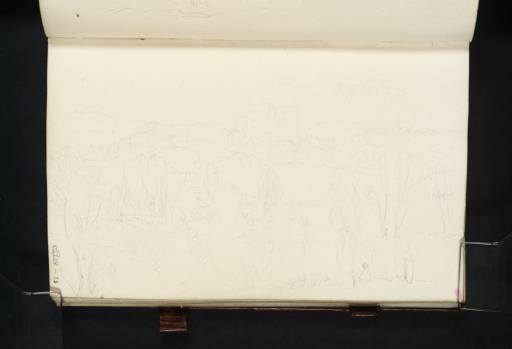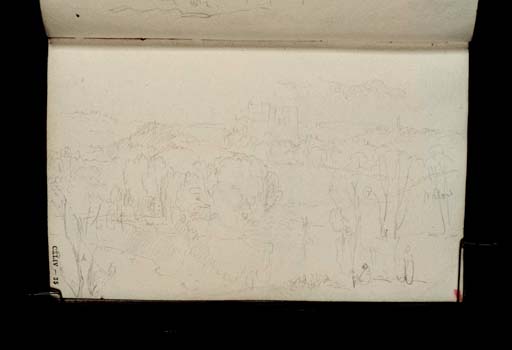Joseph Mallord William Turner Ripon Minster from the North-East, near Sharow 1816
Image 1 of 2
Joseph Mallord William Turner,
Ripon Minster from the North-East, near Sharow
1816
Joseph Mallord William Turner 1775–1851
Folio 35 Recto:
Ripon Minster from the North-East, near Sharow 1816
D10932
Turner Bequest CXLIV 35
Turner Bequest CXLIV 35
Pencil on white wove paper, 97 x 154 mm
Inscribed by Turner in pencil ‘willow’
Inscribed, possibly by John Ruskin, in red ink ‘34’ bottom right, descending vertically
Stamped in black ink ‘CXLIV 35’ bottom left, descending vertically
Inscribed by Turner in pencil ‘willow’
Inscribed, possibly by John Ruskin, in red ink ‘34’ bottom right, descending vertically
Stamped in black ink ‘CXLIV 35’ bottom left, descending vertically
Accepted by the nation as part of the Turner Bequest 1856
References
1909
A.J. Finberg, A Complete Inventory of the Drawings of the Turner Bequest, London 1909, vol.I, p.413, CXLIV 35, as ‘Castle (?) on hill with river in foreground. ?Ripon’.
1996
David Hill, Turner in the North: A Tour through Derbyshire, Yorkshire, Durham, Northumberland, the Scottish Borders, the Lake District, Lancashire and Lincolnshire in the Year 1797, New Haven and London 1996, p.199 (note 45).
This distant view of Ripon Minster1 is taken from the north-east, from the northern end of Bell Bank on left bank of the River Ure slightly upstream of the village of Sharow. The tall obelisk of Ripon market cross, built in 1709, is visible in the right distance, and Turner records figures in the right foreground, one of whom is seated and possibly sketching. The sketch is the first of three taken in the same vicinity: the following spread in this sketchbook, folios 35a–36 (D10933–D10934), shows a similar view of the Minster from a viewpoint slightly further north, while the Yorkshire 3 sketchbook contains one from a lower vantage point and slightly further north again (Tate D11383; Turner Bequest CXLVI 9).
This group of sketches at Bell Bank is Turner’s most concentrated treatment of a single site at Ripon, and he appears to have been deliberately searching along the left bank of the Ure between Hewick Bridge and the Ure Bridge for a view of the town and Minster across the river. Bell Bank was by no means on the beaten path for artists at Ripon, and far less obvious a view than, for example, the one from the Ure Bridge that Turner made in the Yorkshire 3 sketchbook (Tate D11382; Turner Bequest CXLVI 8). Bell Bank is easily visited today on a riverside footpath leading downstream from the Ure Bridge, but the viewpoint is mostly known only locally today. Turner discovered the locality on his first visit to Ripon in 1797 and sketched it on that occasion (Tate D01099; Turner Bequest XXXVI E).
The figures shown in the present sketch prove that Turner was not alone, and it may be that he stayed with a local family in Ripon in 1816. There is a pretty stand of mature trees today at the southern end of Bell Bank, which marks the viewpoint.2 From the number of studies from this area, and from a detailed study of the Minster from this angle but from a nearer viewpoint follows on folio 36 verso (D10935), it would appear that Turner was working towards a finished composition for the Thomas Dunham Whitaker’s projected General History of the County of York.3
David Hill
January 2009
Ripon Minster is also a cathedral and is referred to as both. The former seems preferable since the title refers specifically to its Anglo-Saxon significance. It seems insufficient to argue for the title of Cathedral on the grounds that it is the seat of a Bishop (which indeed it is), when York Minster is happily so called when it is the seat of an Archbishop.
How to cite
David Hill, ‘Ripon Minster from the North-East, near Sharow 1816 by Joseph Mallord William Turner’, catalogue entry, January 2009, in David Blayney Brown (ed.), J.M.W. Turner: Sketchbooks, Drawings and Watercolours, Tate Research Publication, December 2013, https://www


